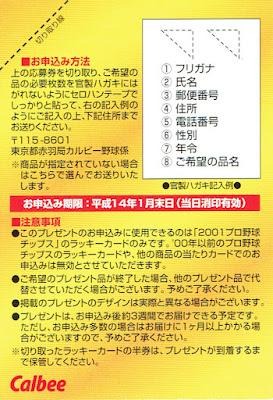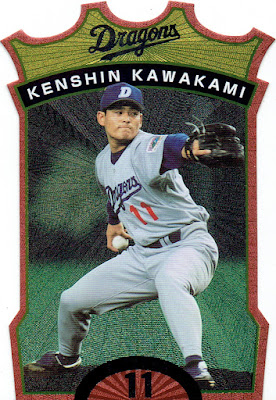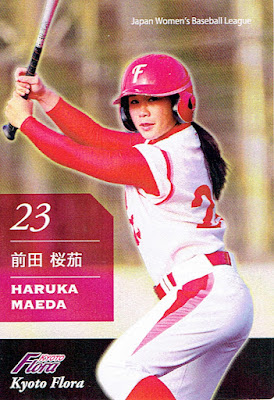I wanted to continue my history of Calbee's baseball cards by doing a post about the OTHER Calbee baseball cards - the ones that didn't come directly out of a pack attached* to a bag of chips (or other snacks). There are two varieties of these - "Lucky" card redemptions and "Special Box Sets" available through a specific retailer.
* To be completely accurate, the packs didn't become physically attached to the bags until around 1996. Before that the buyer would be given the packs by the store owner when they purchased the bags of chips.
"Lucky" cards are cards that can be pulled from the packs and then redeemed for prizes by being mailed to Calbee. The prizes could either be single cards, small separate card sets or a gold signature parallel set of an entire Calbee series of base or insert cards. There were other prizes available through the "Lucky" cards as well such as
albums, baseball guide books and/or notebooks and even
mini-bats. In some years there would be multiple prizes available and you'd have to send in multiple "Lucky" cards to redeem your prize - different numbers of cards would yield different prizes. For example, check out this "Lucky" card from the 2001 Calbee Series One set (I'm showing both the front and back here):


Sending in two "Lucky" cards would get you a small card album, five would get you a "Special" card set containing 12 cards and ten would get you a 72 card "gold facsimile signature" parallel set containing parallels of all 72 "regular" player cards from the 2001 Series One set. The back of the has instructions on how to send the cards to Calbee. I think you're supposed to cut off the upper right corner (well, right side from the front) of the card and send that in,
Back when Calbee started they did
"Home Run" cards instead of "Lucky" cards. The fronts of these were identical to cards in the set but the backs had the redemption instructions on them rather than the regular card backs. These are apparently extremely rare - probably because everyone who got them redeemed them. It looks like Calbee only did these from 1973 to 1980 - I guess that they then switched to the "Lucky" cards but I don't know that for sure.
What follows is an attempt at a comprehensive list of the types of cards available as prizes over the 50 years Calbee's been doing cards. I'm going to concentrate on the cards that aren't simply "gold facsimile signature" parallels of the regular cards.
In 1973, Calbee offered up a bunch of postcard sized, blank backed cards as prizes. I think you only got one card per redemption. It's not known how many of these exist - Engel lists 21 but one of the two I own is not on his list. I have a card of Sadaharu Oh swinging a sword and a group photo of Tsuneo Horiuchi, Masaji Hiramatsu and Yutaka Entasu which I suspect was taken at an All Star game - maybe in Osaka Stadium? The group card is the one that Engel doesn't list:


In 1977 Calbee issued two sets of stickers - a 36 "card" set featuring only players from the Dragons, Carp, Giants and Tigers and a 26 "card" "All Star" set featuring 13 players from each of the two leagues. In addition they issued a set of "standup" cards that all featured Giants players. There are 18 known cards for 11 players (five players have two cards each and Sadaharu Oh has three). It is not clear if these cards were available as prizes, were inserted into the regular packs or issued separately. I think these are very rare. I don't have any of them but I did swipe images of one of the Oh "standup" cards off of Ebay:
After that it appears to have been another 12 years before Calbee issued any cards as prizes again. In 1989 they issued six hologram cards which are also incredibly rare. Again, I don't know for sure that these were prize cards but it seems likely. Unfortunately I don't have any of these cards.
In 1990 Calbee gave away oversize (3 1/2 inch by 5 inch) cards as prizes. These were issued in two series although I do not know how those series correlated to the four series that the regular set was issued in. The first series of "Big" cards contained 16 cards with borders and backs with player information on them while the second much more rare series had 28 borderless, blank backed cards with the player's facsimile signature on the front. I only have cards from the first series - here's the front and back of one of them:
Calbee did oversized prize cards again in each of the following three years. These cards differed from the 1990 cards by being a little smaller (3 3/16 inches by 4 19/32 inches) and by having designs that were very similar to the regular Calbee cards for each respective year. There were 24 cards each in the 1991 and 1992 sets and 27 in the 1993 set. Here are examples of the 1991 and 1992 cards - I don't have any of the 1993 ones:




The next prize cards wouldn't be until 1998. There were two varieties of these. There was a nine card "Rivals" set that could be acquired by sending in ten "Lucky" cards for the first series. These appear to be very rare and I don't have any of them. A little on the easier side were the "CD" cards - six of which were available for three "Lucky" cards apiece in each series for a total of 18 cards altogether. These were die-cut cards that were a little larger than standard size cards that were issued in a clear plastic CD case. I picked up one of these at
Mint Umeda but the CD case got cracked in my luggage during my trip:


Calbee had a "special card" set available as a prize for each of year between 1999 and 2001. The 1999 and 2000 sets contained 24 cards and appear to have each been issued in two 12 card series. I'm not sure how the 1999 cards were done as Calbee's on-line checklist associates both series with
Series One of the set. The first 12 cards of the 2000 set appear to have been available with "Lucky" cards from
Series One while the other were available with ones from
Series Two (and no "special card" set was associated with
Series Three). For 2001 the "special card" set only had 12 cards and was associated only with
Series One. I don't have any of the 1999 cards but here's an example from the 2000 and 2001 sets - keep in min that they are shiny cards that don't scan well:




After 2001 there was another long gap before Calbee again gave away cards that were not simply parallels of the regular or insert cards. In 2014 they gave away six 3-D cards - two per series - and in 2015 they again did 3-D cards although it was only two in all - one in Series One and one in Series Two. I don't have examples of any of these cards.
The Calbee Collector website has
a page listing a lot of the prizes that were available over the years via "Lucky" card redemption. Unfortunately the listing stops at 2014.
Starting in 2004, Calbee issued small box sets of cards through another retailer. From 2004 to 2006, this retailer was Karnac Karubiya (or at least that's how Google translated their name). Once they went out of business in 2007 Calbee issued the sets through their eShop for the next four years (not sure if the Karnac Karubiya issued the sets in stores or only through their website). After a two year gap in 2011 and 2012, they started issuing the sets again via the "Calbee Online Shop" before I think they switched to selling via
their Amazon.co.jp store in 2015. (It's a bit confusing - they may have started selling with Amazon as early as 2013 and I swear to God I've never found the sets at their store.) They've issued one set with every card series they've done since 2004 (with the exception of 2011 and 2012) so there's been three sets each year (except 2017 when Calbee only issued two series). Instead of trying to write something about each of these 50 sets, I put together a table listing them all. Each set contains 12 cards unless otherwise indicated. I added some detail about a couple of the sets since I felt the name wasn't clear - most of these are self-explanatory:
| Year |
Store |
Series One |
Series Two |
Series Three |
| 2004 |
Karnac Karubiya |
Sluggers |
Ace Pitcher |
Hard Hitter |
| 2005 |
Karnac Karubiya |
Over 30 Home Run (18) |
Lead Off Man |
Closer |
| 2006 |
Karnac Karubiya |
Title Holder (21) |
Veteran |
Battling Leader |
| 2007 |
Calbee eShop |
Slugger |
Speedster |
Ace |
| 2008 |
Calbee eShop |
Title Holder (20) |
AVG Leader |
Closer |
| 2009 |
Calbee eShop |
Title Holder (21) |
Veteran |
Iron Arm |
| 2010 |
Calbee eShop |
Title Holder (19) |
Hits Leader |
Shortstop |
| 2013 |
Calbee Online Shop |
Best 9 (15) |
Speed Star |
Strikeout Leader |
| 2014 |
Calbee Online Shop |
Title Holder (19) |
AVG Leader |
Guardian (Closers) |
| 2015 |
Amazon |
Title Holder (24) |
Wins Leader |
Career Hits Leader |
| 2016 |
Amazon |
RBI Leader |
Wins Leader |
AVG Leader |
| 2017 |
Amazon |
Clutch Hitter |
Opening Pitcher |
N/A |
| 2018 |
Amazon |
AVG Leader |
Wins Leader |
RBI Leader |
| 2019 |
Amazon |
Strikeout Leader |
Hits Leader |
Control Tower (Catchers) |
| 2020 |
Amazon |
Slugger |
Wins Leader |
Opening Cleanup Hitter |
| 2021 |
Amazon |
Strikeout Leader |
RBI Leader |
Total Victory |
| 2022 |
Amazon |
Clutch Hitter |
Opening Pitcher |
Home Run Leader |
I only have examples from three of these sets - the 2006 "Veteran", the 2020 "Slugger" and the 2022 "Clutch Hitter" sets:
In addition to these box sets that were issued in conjunction with the regular sets, Calbee also issued one of them with their 2019 Samurai Japan set. This was an eight card set featuring highlights of several of the games that Samurai Japan had played between November, 2017 and November, 2018 - with the exception of their games against the MLB All Stars in November 2018. I don't know for sure if this set was available from Calbee's Amazon store or if it was a "Lucky" card redemption but I suspect it was from Amazon. Calbee no longer lists this set with the 2019 Samurai Japan checklist so I can't check what it says (and it's not archived at the Wayback Machine). I did a post about this set when I got it in December of 2019 but here's one card from it as an example - this is Kodai Senga:
































































